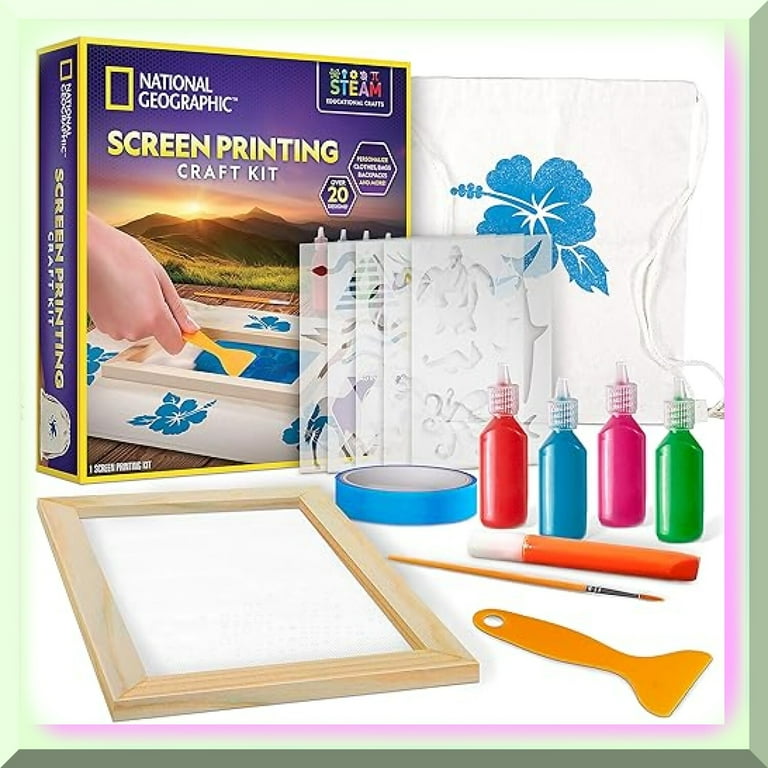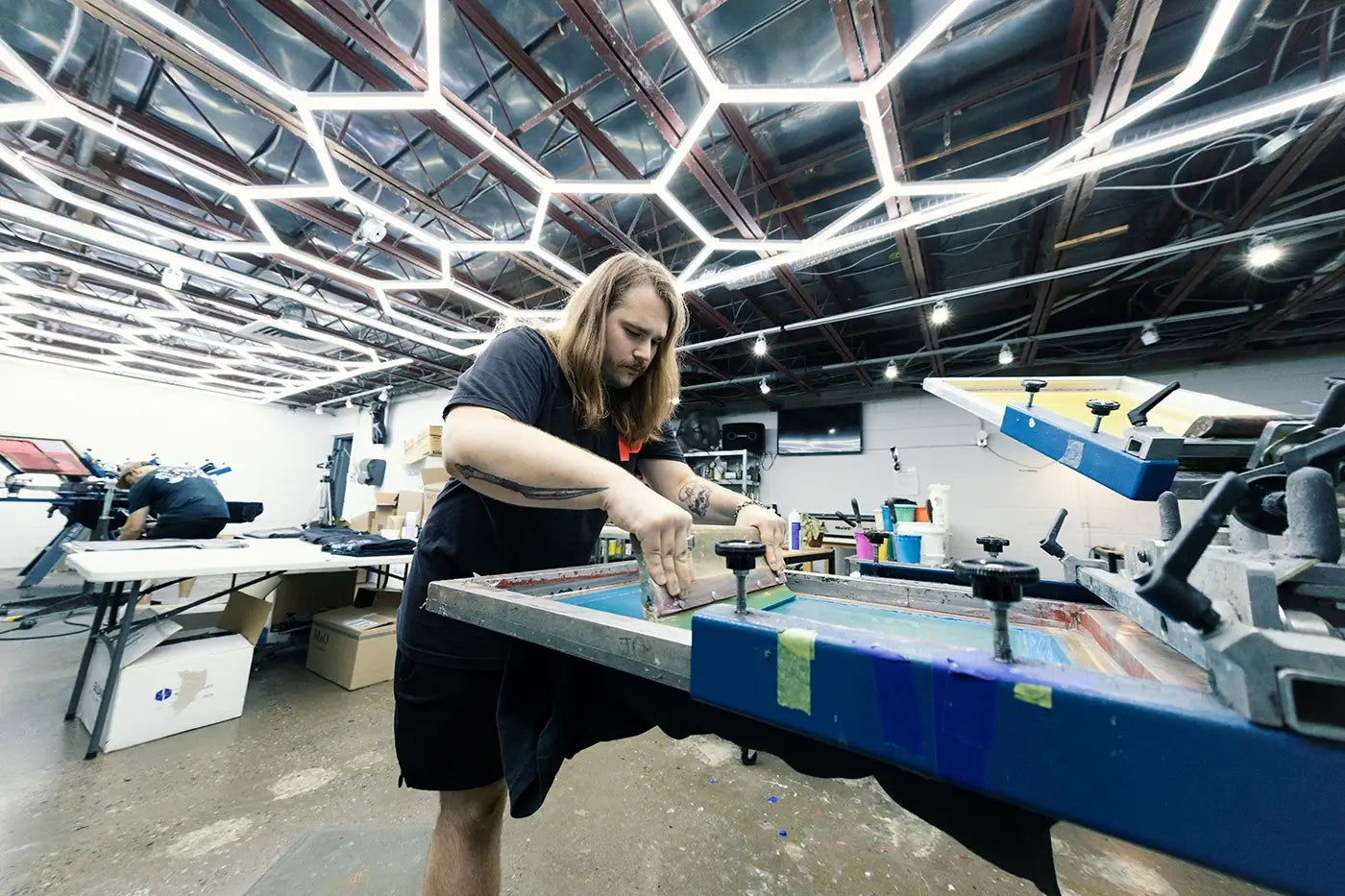Professional Screen Printing Kit for Custom Apparel
Professional Screen Printing Kit for Custom Apparel
Blog Article
Mastering Silk Screen Printing: Advice for Creating Stunning Layouts
If you're looking to master silk screen printing, you'll require more than simply interest. By the end, you'll be prepared to produce magnificent layouts that reflect your unique style.
Understanding the Basics of Silk Display Printing
Silk display printing, often called display printing, is a functional method for transferring designs onto numerous materials. You'll discover it's ideal for printing on textiles, paper, plastic, and extra. The process entails producing a stencil, or display, that permits ink to travel through just in particular locations, producing vibrant and clean designs.
To begin, you'll require to prepare your art work, ensuring it's in an appropriate layout. screen printing kit. When you've obtained your design ready, you'll coat your screen with a light-sensitive emulsion and reveal it to light. This step creates a pattern of your layout on the screen
After cleaning out the unexposed emulsion, you're established to publish. Straighten your screen over your product, use ink, and use a squeegee to push the ink with the display. It's everything about practice and patience, so do not wait to experiment and improve your method as you go.
Necessary Tools and Products You'll Need
To begin with silk screen printing, you'll require a couple of basic products like screens, mops, and ink. You can check out sophisticated tools that enhances your printing top quality and efficiency as soon as you're comfy. Let's discuss what you'll require to ensure your jobs are effective from the beginning.
Standard Silk Screen Materials
Starting on a silk display printing project calls for a few necessary tools and products to ensure your success. You'll need a silk display framework, which holds the mesh that transfers your style. A squeegee is important for pushing ink with the display onto your substrate. Don't fail to remember the ink itself; choose shades that fit your design and the material you're printing on. A source of light is essential for subjecting your display, along with solution to develop your pattern. You'll additionally need a correct office, preferably one that's well-lit and cost-free from dirt. Lastly, supply up on cleaning products to preserve your tools and maintain your screens in excellent condition. With these fundamentals, you're prepared to dive into your task!
Advanced Printing Devices
When you're ready to take your silk screen printing to the next degree, buying advanced printing tools can make a considerable distinction. A premium display printing machine is essential; search for a multi-color press that enables specific registration and quicker manufacturing. You'll also desire to update to an extra efficient direct exposure device to ensure your layouts are dynamic and sharp.
Consider investing in a trustworthy warmth source, like a conveyor clothes dryer, for also healing of inks. Don't forget specialized inks; water-based and discharge inks give outstanding results on numerous fabrics. A great collection of squeegees and solution scoop coater will streamline your procedure, offering your designs that professional side.
Preparing Your Art Work for Printing
Preparing your artwork for silk display printing is vital to accomplishing vivid, specialist outcomes. Beginning by verifying your design is in the ideal layout-- vector files like.AI or.EPS work best. By doing this, your art work keeps top quality at any type of size. Next, examine the shade mode; use CMYK for accurate color representation.
As soon as your documents is ready, create a separate layer for every shade in your layout. This'll make it simpler during the printing procedure. Don't forget to add enrollment marks to align shades appropriately.
Likewise, consider the mesh count of your screen; better details might need a higher mesh count. Lastly, save your artwork with a resolution of at least 300 DPI to guarantee crisp prints. By complying with these steps, you'll set yourself up for an effective printing experience and bring your designs to life magnificently.
The Screen Printing Refine: Step-by-Step
Currently that you've prepared your art work, it's time to concentrate on the display printing process itself. You'll start by preparing your display, ensuring it awaits the ink application. From there, you'll explore numerous printing strategies to accomplish the very best outcomes for your project.
Preparing Your Display
Getting your screen all set is a crucial step in the silk screen printing process. Tidy the screen completely to get rid of any type of dirt, residue, or grease. Use a degreaser and rinse it well to guarantee a smooth surface area for your solution. Next off, apply a light layer of emulsion evenly throughout the screen using an inside story coater. Make certain to do this in a poorly lit area to stop premature exposure. Permit the solution to dry totally prior to subjecting it to your layout. When completely dry, position your transparency on the screen and utilize a light to reveal the design. After direct exposure, wash out the unexposed emulsion, and you'll have your display gotten ready for printing.
Printing Methods Discussed
Once your display is prepared, you can plunge into the interesting process of printing. Next off, put your ink onto one side of the screen and use a squeegee to pull the ink across the design. Tidy your screen quickly to protect against ink from drying out and blocking the mesh.
Tips for Getting Vibrant Colors
While attaining dynamic colors in silk screen printing might seem tough, you can conveniently raise your designs with a few crucial strategies. Initially, pick high-quality inks especially made for silk display printing; they provide better pigmentation and insurance coverage. Blending inks effectively can additionally enhance vibrancy-- explore proportions to discover the best blend that stands out.

Finally, do not forget about treating your prints appropriately. Proper warmth setting guarantees the colors bond with the material, preserving their vibrancy over time. By carrying out these methods, you'll develop stunning, captivating styles that truly beam.
Repairing Typical Printing Issues
Even with vibrant colors in your layouts, silk screen printing can often present difficulties. One typical concern is ink bleeding, which commonly takes place when you make use of as well much ink or don't let the previous layer dry totally. To avoid this, utilize a squeegee with just the appropriate pressure and ensure each layer is go to these guys dry prior to including more.
If your design isn't lining up appropriately, verify your registration marks and make modifications to your screens. Clean your screens thoroughly before starting your print run.
Finally, if the ink isn't sticking well to the textile, think about the material kind and the treating procedure. Ensure you're making use of the right ink and that you're healing it at the ideal temperature level. Fixing these common problems will help you attain magnificent outcomes.
Explore Strategies and Impacts
Trying Visit This Link out different strategies and effects can raise your silk display printing projects to brand-new elevations. Do not hesitate to push limits! Attempt layering shades for deepness; overlapping hues develops distinct blends that catch the eye. You can likewise have fun with textures-- utilizing different squeegee methods or including materials like sponges or brushes includes dimension to your prints.
Take into consideration making use of specialized inks, such as glow-in-the-dark or metal, to provide your layouts an unexpected spin. You may also discover stenciling, where you can cut elaborate designs for magnificent impacts.
Do not neglect about substrate variations! Printing on textiles, wood, or paper can yield different outcomes that boost your task's feeling.
Ultimately, maintain a journal of your experiments. Documenting your successes and failures will certainly assist your future developments and assist you fine-tune your style. Welcome the procedure, and delight in the trip of finding what jobs best for you!
Regularly Asked Questions
How Do I Clean and Preserve My Screen Printing Equipment?
To clean up and keep your screen printing tools, routinely scrub screens with a suitable cleaner, laundry squeegees after usage, and shop everything in a completely dry, dust-free environment. Keeping points tidy assurances much better prints and longer-lasting devices.

Can I Print on Materials Apart From Fabric?
Take into consideration utilizing timber, plastic, or paper. Simply make certain your inks and screens are suitable with those surfaces for the finest outcomes.
What Is the Ideal Means to Store Screens and Inks?
To store inks and displays efficiently, keep displays upright in an amazing, completely dry area, and cover them to protect against dirt. Shop inks in closed containers, away from direct sunlight, to keep their high quality and uniformity.
Just how Do I Pick the Right Mesh Matter for My Task?
Selecting the best mesh count depends on your design's detail and ink type. For vibrant layouts, a lower count, around 110, functions finest.
What Are the Environmental Effects of Silk Screen Printing?
Silk display printing can have environmental impacts, like chemical waste and water usage. this website You can minimize these by utilizing environmentally friendly inks, recycling materials, and appropriately dealing with chemicals to lower your task's eco-friendly impact.
Silk screen printing, usually called screen printing, is a functional technique for moving designs onto different materials. Align your screen over your material, apply ink, and use a squeegee to press the ink through the screen.To get started with silk display printing, you'll need a few fundamental products like screens, mops, and ink.When you're prepared to take your silk display printing to the following degree, spending in innovative printing equipment can make a significant distinction.Obtaining your display all set is an essential step in the silk display printing procedure.
Report this page